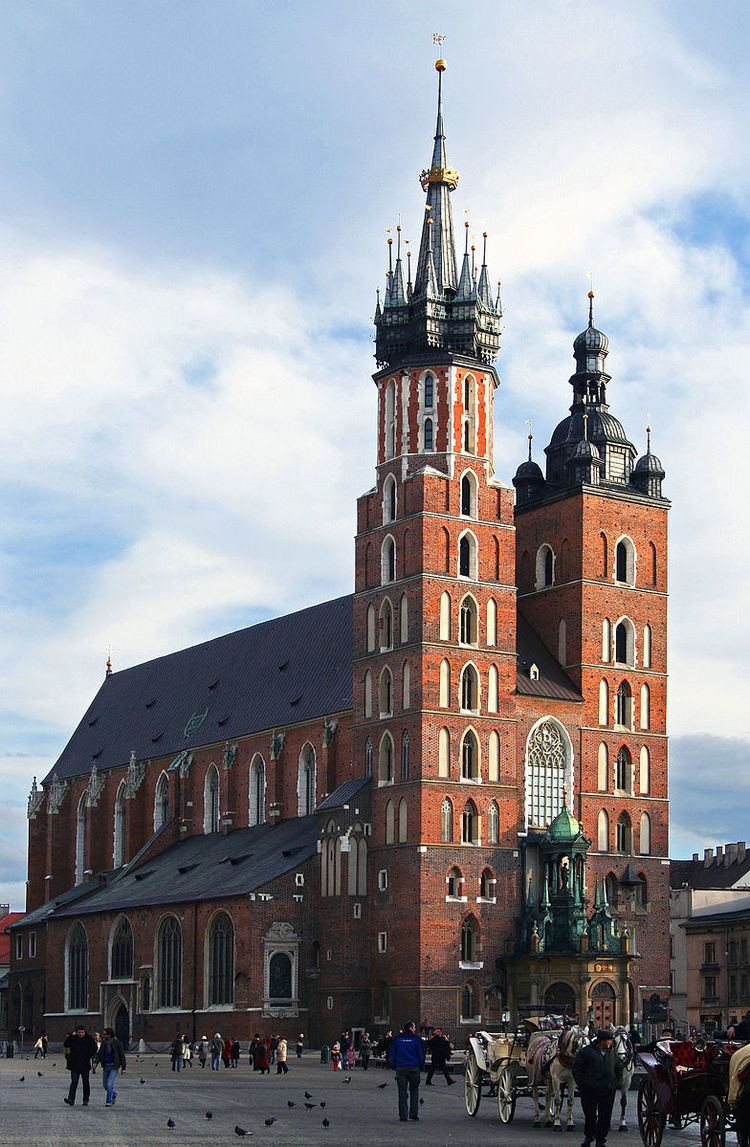Location Kraków Denomination Roman Catholic Completed 1347 Opened 1347 Founder Casimir III the Great | Country Poland Architectural type Gothic-style Height 80 m Phone +48 12 422 05 21 Burials Jan Leopolita | |
 | ||
Address plac Mariacki 5, 31-042 Kraków, Poland Architectural styles Polish Cathedral style, Gothic architecture Similar Kraków Cloth Hall, Wawel Castle, Wawel Cathedral, Main Square - Kraków, Wawel Profiles | ||
St mary s basilica krak w poland 23rd may 2014
Church of Our Lady Assumed into Heaven (also known as St. Mary's Church; Polish: Kościół Wniebowzięcia Najświętszej Maryi Panny (Kościół Mariacki)) is a Brick Gothic church re-built in the 14th century (originally built in the early 13th century), adjacent to the Main Market Square in Kraków, Poland. Standing 80 m (262 ft) tall, it is particularly famous for its wooden altarpiece carved by Veit Stoss (Wit Stwosz).
Contents
On every hour, a trumpet signal—called the Hejnał mariacki—is played from the top of the taller of St. Mary's two towers. The plaintive tune breaks off in mid-stream, to commemorate the famous 13th century trumpeter, who was shot in the throat while sounding the alarm before the Mongol attack on the city. The noon-time hejnał is heard across Poland and abroad broadcast live by the Polish national Radio 1 Station.
St. Mary's Basilica also served as an architectural model for many of the churches that were built by the Polish diaspora abroad, particularly those like St. Michael's and St. John Cantius in Chicago, designed in the Polish Cathedral style.
The church is familiar to many English-speaking readers from the 1929 book The Trumpeter of Krakow by Eric P. Kelly.
History
According to chronicler Jan Długosz St. Mary's Bacilica in the Main Square in Kraków was founded in 1221–22 by the Bishop of Kraków, Iwo Odrowąż. The building was destroyed during the Mongol invasion of Poland. Between 1290–1300 the new early Gothic church was built on the remaining foundations. It was consecrated twenty years later, in 1320.
The church was completely rebuilt under the reign of Casimir III the Great between 1355 and 1365 with substantial contributions from wealthy restaurateur Mikołaj Wierzynek. The presbytery was elongated and tall windows added. The main body of the church was completed in 1395–97 with the new vault constructed by master Nicholas Werhner from Prague. However, the vault over the presbytery collapsed in 1442 due to a possible earthquake, which has never happened before nor since in Kraków.
In the first half of the 15th century, the side chapels were added. Most of them were the work of master Franciszek Wiechoń. At the same time the northern tower was raised and designed to serve as the watch tower for the entire city. In 1478 carpenter Maciej Heringh (or Heringk) funded a helmet for the tower. A gilded crown was placed on it in 1666, which is still present today. At the end of the 15th century, St Mary's church was enriched with a sculptural masterpiece, an Altarpiece of Veit Stoss (Ołtarz Mariacki Wita Stwosza) of late Gothic design.
In 1536/37 King Sigismund I. declared that the sermons in the church should be changed from German to Polish. The large German community of Cracow was relocating their placce of whorship to the smaller St. Barbara's church.
In the 18th century, by the decision of vicar Jacek Augustyn Łopacki, the interior was rebuilt in the late Baroque style. The author of this work was Francesco Placidi. All 26 altars, equipment, furniture, benches and paintings were replaced and the walls were decorated with polychrome, the work of Andrzej Radwański.
At the beginning of the 19th century, the city has decided that a cemetery near the Basilica was to be shut down and made into a public square. Today it is known as Plac Mariacki (The Marian Square). In the years 1887–1891, under the direction of Tadeusz Stryjeński the neo-Gothic design was introduced into the Basilica. The temple gained a new design and murals painted and funded by Jan Matejko, who worked with Stanislaw Wyspianski and Józef Mehoffer - the authors of stained glass in the presbytery.
On 18 April 2010, in St. Mary's Basilica, a funeral ceremony for Polish President Lech Kaczynski and his wife Maria was held. The coffins were later transported and buried in one of the crypts of Wawel Cathedral.
